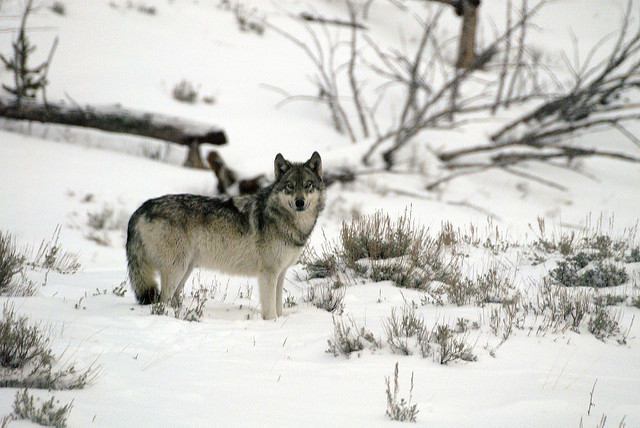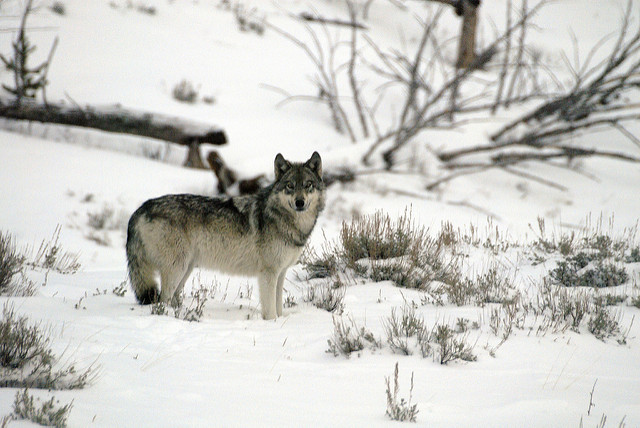Yellowstone: A Wild Place of Perpetual Discovery
Wolves draw visitors to national park in cold winter months
Yellowstone National Park, established in 1872 as America’s first national park, welcomed more than 4 million visitors in 2015, a number that has steadily grown in recent years. The home of free-ranging bison, elk, wolves, bears, and bighorn sheep, among other iconic fauna, is firmly on the radar screen of many travelers heading to the northwestern section of Wyoming and nearby Montana and Idaho for summer vacation.
During the winter months, when the grizzly bears and black bears are hibernating, visitor numbers drop precipitously. The only main road open in Yellowstone stretches from the northern entrance at Gardiner, MT, to the northeastern entrance at Cooke City, MT, along the way passing the geothermal hotspot of Mammoth Hot Springs and the wildlife-rich Lamar Valley.
The impetus for my trip, like many winter visitors to Yellowstone, was to see the national park’s world-famous and ever-debated gray wolves. The wintery landscape provides some of the best wild viewing of these predators, which were reintroduced in 1995 after loss of habitat and “extermination programs” eradicated them from their historic range. It’s believed that Yellowstone’s last gray wolf was killed in 1926, and it took the passage of the Endangered Species Act in the 1970s and years of planning to bring a few dozen gray wolves from western Canada and eventually northwestern Montana to the park.
The National Park Service’s 2014 report on wolves indicates that the animals are spread across 11 packs and number at least 104. Their chosen prey throughout the monitoring period included elk (65 percent of kills) and bison (9 percent), among other animals. The pack names are well known to the park’s wolf enthusiasts, some of whom make daily treks to view them in the wild. From the Lamar Canyon pack to the Prospect Peak pack to the Mollie’s pack, the wolves are tracked with the help of GPS collars on a select number of the predators.
Wolves are typically spotted from a far distance, but when one of these canids can be caught in the viewfinder of a long-lens camera or, better yet, by the naked eye, the moment is still one of profound significance.
I visited the park for a few days on a trip with the Yellowstone Association, an educational nonprofit in which this reporter is a new member. With a wildlife biologist at the wheel of our bus, the group headed each morning for the Lamar Valley, a stretch of land in the northern part of the park. In our first forays on the road, common animals received requisite oohs and aahs, prompting the tour guide to park in a pullout and let us take pictures and grab a closer look. From scavenging coyotes to herds of snowy bison to bull elk with branch-like antlers, the animals of this unique ecosystem — even the ones that number in the thousands — are every bit as worthy of a spectator’s attention and camera clicks as the wolves.
But the wolves command the most engrossment in winter. Motorists in cars and vans head toward the likely viewing spots, often following the vehicles decked out with radio telemetry that receive signals from the collared wolves. For others, it’s easy enough to stop when there’s a small crowd of people on the roadside looking off into the distance. During the first week of January, the packs were moving and eating close enough to the road for concentrated binocular gazes and careful positioning of iPhones in attempts to snag haloed images through a spotting scope.
The crowds in January are miniscule compared to the busier summer months. The National Park Service estimates that in January 2015 just under 5,400 vehicles entered the northern gate at Gardiner, MT. In July 2015, that number ballooned to 335,993 vehicles from the five gates.
One day during the trip we saw two packs: the so-called Junction Butte and Mollie’s packs. The Junction Buttes, in particular, were active near their namesake area of the park. After viewing the wolves in the distance for a while, it became clear that more members of the pack were actually across the road behind us, the gazing tourists in their land. Their howling was sustained and appropriately beautiful against the backdrop of snowy mountains and chilled tourists who could see their breath.
Sure enough, one of the gray wolves of the Junction Butte pack emerged close to the parked vehicles and not far from our scopes. The gray wolf, which was actually black in color, ran across the road to join with his or her brethren. Meeting this wolf on the other side, and in perfect display for the wolf watchers, was a group of pack mates who ran at a fast clip — they joined together and jumped up and down, socializing in the early-morning hours.
Later in the day, we saw the Mollie’s taking a snooze on a mountaintop. The large pack — there were probably a dozen wolves in view — was also spotted the next day on the peak of a nearby mountain, apparently enjoying their spoils from a recent kill. As the wolves of the Mollie’s pack sat and slept off their likely full bellies, a coyote or two scavenged the remains of the carcass farther down the mountain. A few imposing birds — one probably a golden eagle — stood sentinel in a nearby conifer. In the span of a few minutes the full cycle of Yellowstone wildlife was on display.
The final day of the three-day tour included another kill, a bull elk left near the roadside. The wolves, this time the Lamar Canyon pack, were far off on a mountainside. The theory among the assembled wolf enthusiasts was that the wolves were feasting on a different kill, while two of their pack mates had taken care of this elk down below. Whatever the case, what looked like Park Service employees decided to move the elk carcass farther away from the road, probably to keep the wolves and other animals away from the dangers of passing vehicles.
The impetus of the trip was to see the wolves during wintertime, and yet I left with a great understanding of the connective tissue of Yellowstone’s ecosystem. Thanks to Paul Schullery’s thoughtful Searching for Yellowstone, our helpful guide, and the shared sense of discovery of strangers brought together over a common interest in wildlife and nature, I understood, even after just a few days, why so many visitors have admired this historic land. I was conscious of the park’s controversial history and continuing management issues, encompassing everything from bison culling to overcrowding of human visitors. But more than anything, I was awed by the fauna, and appreciative that this experiment is continuing and hopefully will continue, first and foremost, for the animals’ sake, but also for ours, and for the splendor of the land itself.
These wolves, better than any other example that comes to mind, are a perfect way of appreciating this wild place of perpetual discovery.

